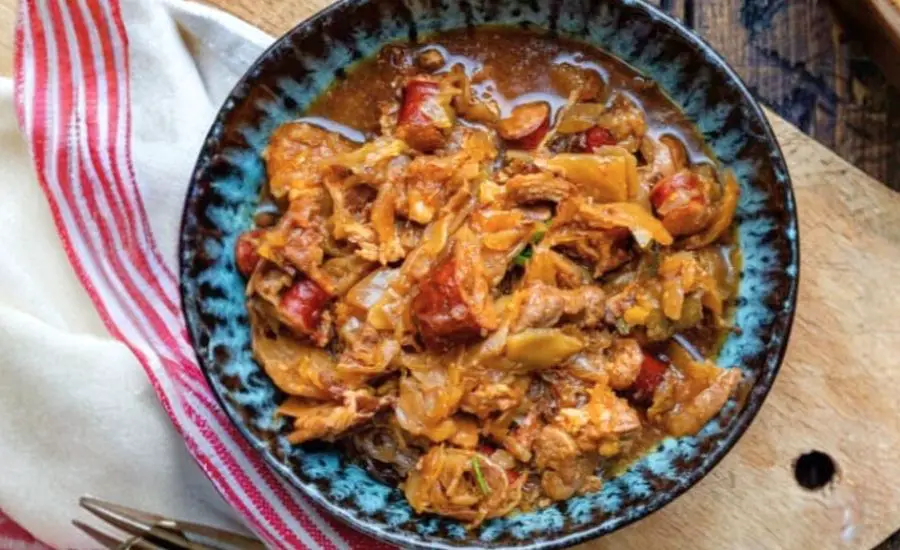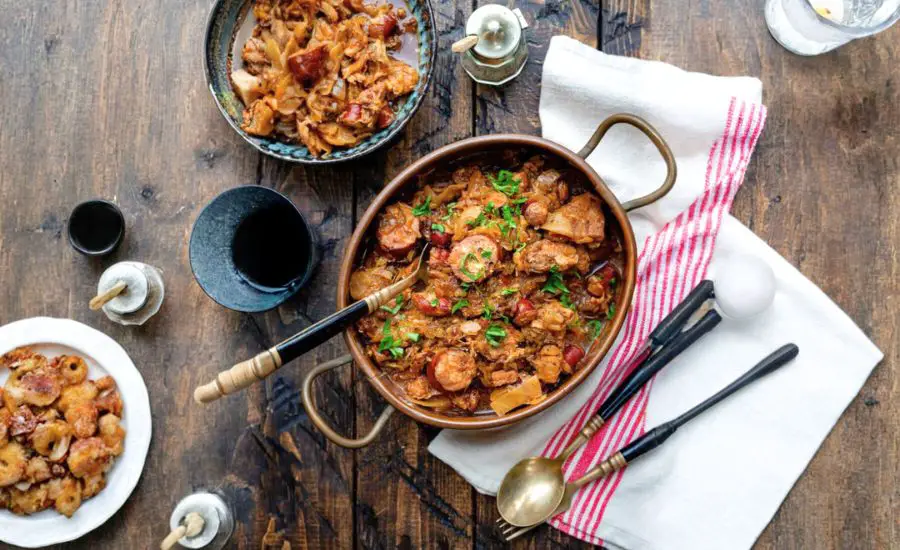All products are selected by our editorial team for quality. If you buy through our links, we may earn a small commission at no extra cost to you.
Bigos, often called the Polish hunter’s stew, is a wonderfully hearty and flavorful dish that brings together a rich combination of meats, sauerkraut, cabbage, and prunes.
This stew stands out for its deeply satisfying texture and balanced flavors that develop over slow cooking, making it ideal for chilly days.
Nutritionally, Bigos is a powerhouse—high in protein thanks to its mix of pork and sausage, while the sauerkraut and cabbage provide a generous boost of fiber and beneficial probiotics.
The inclusion of prunes adds natural sweetness and important micronutrients.
Despite being rich and filling, this recipe can easily fit into a low-carb or keto lifestyle by simply omitting the prunes.
It’s perfect for everyday meals as it’s mostly hands-off with a slow cooker, making meal prep a breeze.

The recipe’s ability to feed a crowd or provide multiple leftovers means you get convenience without sacrificing traditional, comforting flavors.
Must-Have Tools for Perfect Results
6-Quart Slow Cooker
Essential for slow simmering Bigos, this cooker ensures all ingredients meld perfectly over hours, delivering tender meat and rich flavors. Beyond this recipe, it’s ideal for easy meal prep and effortless weeknight dinners.
Large Casserole or Saute Pan
Used to brown the bacon, sausage, and pork, this pan builds foundational flavors through caramelization. A versatile staple in any kitchen, it’s perfect for searing, sautéing, and even one-pot meals.
Measuring Jug
Perfect for soaking dried porcini mushrooms in boiling water, this tool ensures precise liquid measurements. It’s invaluable for any recipe requiring accurate hydration or liquid additions.
Slotted Spoon
Allows easy transfer of browned meats without excess fat, helping maintain the stew’s perfect texture. This tool also aids in serving and skimming tasks in everyday cooking.

Hearty Bigos Stew (Polish Hunter’s Stew)
Equipment
- Slotted Spoon
- Measuring Jug
- large casserole or sauté pan
- 6-quart slow cooker
Ingredients
- 50 g dried porcini mushrooms
- 250 ml boiling water
- 6 strips thick-cut streaky bacon diced
- 450 g Polish Kielbasa cubed
- 4 Polish Kabanos sausages sliced
- 3 tbsp vegetable oil as needed
- 450 g boneless pork loin or shoulder cubed, fat removed
- 2 onions diced
- 1 small white cabbage cored and shredded
- 900 g raw organic sauerkraut drained
- 10 stoned prunes halved (or canned, drained)
- 2 tbsp tomato paste
- 3 bay leaves
- 1 tbsp caraway seeds
- ½ tsp allspice or 4 allspice berries
- 3 juniper berries optional
- 480 ml Polish beer or dry red wine or more stock
- 240 ml low-sodium beef stock
- Salt and pepper to taste
Instructions
- Prepare the Porcini Mushrooms Soaking: Begin by placing the dried porcini mushrooms into a heatproof measuring jug or small bowl. Pour 250 ml of boiling water over the mushrooms to fully submerge them. Allow them to soak for about 20-30 minutes. This process will rehydrate the mushrooms, making them tender and releasing their deep, earthy flavor into the soaking liquid, which you will use later in the stew for added richness.
- Crisp the Bacon Base: Heat a large casserole dish or sauté pan over medium heat. Add the diced thick-cut streaky bacon and cook slowly, stirring occasionally, until the fat begins to render and the bacon starts to turn crisp and golden. This step not only enhances the flavor of the bacon but also provides a flavorful fat base that will infuse the stew with smoky richness.
- Brown the Sausages for Flavor: Add the cubed Polish Kielbasa and sliced Polish Kabanos sausages to the pan with the bacon. Cook them over medium heat, stirring frequently to brown evenly, until the sausages are nicely caramelized on the outside—about 8 to 10 minutes. Browning the sausages intensifies their smoky, savory qualities and adds layers of flavor to the stew. Once browned, use a slotted spoon to carefully transfer the meats to your slow cooker, leaving the rendered fat behind in the pan.
- Brown the Pork Cubes in Batches: Next, add a tablespoon of vegetable oil to the same pan if needed to prevent sticking. Add the cubed pork loin or shoulder in batches to avoid overcrowding, which will cause the meat to steam rather than brown. Cook each batch over medium-high heat, turning the pieces occasionally until all sides develop a rich golden crust. This Maillard reaction creates a depth of flavor essential for hearty stews. Once browned, transfer the pork cubes to the slow cooker alongside the sausage and bacon.
- Sauté Onions and Cabbage for Sweetness: Reduce the heat to medium and add the diced onions to the pan. Stir and cook the onions for about 5 minutes until they soften and become translucent, releasing their natural sweetness. Add the shredded white cabbage and continue cooking for another 5 minutes, stirring frequently. If the pan begins to dry out, add a splash of Polish beer, dry red wine, or beef stock to loosen any browned bits stuck to the pan—these bits are packed with flavor.When the cabbage has softened slightly, transfer this mixture into the slow cooker.
- Add Sauerkraut and Prunes for Tang and Sweetness: Drain the raw organic sauerkraut well to avoid excess liquid diluting the stew. Add it to the slow cooker along with the halved prunes. The sauerkraut brings a tangy, fermented acidity that cuts through the richness of the meat, while the prunes add a subtle natural sweetness and a hint of depth that balances the stew beautifully.
- Incorporate Porcini Mushrooms and Seasonings: Carefully add the soaked porcini mushrooms along with their flavorful soaking liquid to the slow cooker. Then stir in the tomato paste, bay leaves, caraway seeds, allspice (or whole allspice berries), and optional juniper berries. These aromatics and spices create the signature, complex taste that defines Bigos, evoking the woodland flavors and traditional Polish heritage.
- Pour in Liquids for Slow Cooking: Measure and pour 480 ml of Polish beer or dry red wine into the slow cooker, followed by 240 ml of low-sodium beef stock. The combination of these liquids provides moisture for slow cooking and enriches the stew’s depth without overpowering the other ingredients. Stir gently to combine all components evenly.
- Slow Cook for Tenderness and Flavor Development: Cover the slow cooker with its lid and set it to the LOW heat setting. Let the stew cook undisturbed for 8 to 10 hours, or overnight if preferred. This long, slow cooking time allows the pork to become tender, the flavors to meld harmoniously, and the sauerkraut and spices to infuse every bite with authentic Polish comfort.
- Final Seasoning and Serving Preparation: Once the cooking time is complete, remove the bay leaves and any whole spices like allspice berries or juniper berries, if used. Taste the stew and adjust the seasoning with salt and freshly ground black pepper as needed—remember that the sausages and sauerkraut already contribute saltiness, so it’s best to season at the end. Serve the Bigos hot, ideally alongside hearty rye bread or over creamy mashed potatoes for a satisfying meal.
Notes
- Browning the meats before slow cooking is crucial for developing deep, rich flavors in the stew.
- Soaking dried porcini mushrooms rehydrates them and adds a unique earthy flavor—don’t skip this step.
- If your sauerkraut is very acidic or vinegary, rinse it lightly before adding to balance the stew.
- For a keto-friendly version, simply omit the prunes to reduce sugar content.
- Bigos tastes even better the next day as the flavors continue to meld—perfect for leftovers.
- Use a well-sized slow cooker (6-quart or larger) to avoid overcrowding and ensure even cooking.
- Adjust salt at the end because the sausage and sauerkraut can be naturally salty.
Chef’s Secrets for Flavorful Stew
One of the biggest secrets to an unforgettable Bigos stew is the initial browning of each meat component.
Taking the time to sear bacon, sausages, and pork separately not only locks in juices but creates caramelized, savory bits that deepen the stew’s complexity.
Additionally, soaking the porcini mushrooms fully and using the soaking liquid is a simple way to inject an earthy richness that complements the smoky meats.
When cooking, don’t rush the slow cooker—low and slow is the way to achieve tender textures and well-developed flavors.
Using a mix of sausages adds layers of smoky, spicy, and herbal notes, making the stew truly multi-dimensional.
Lastly, seasoning at the end is key because the meats and sauerkraut bring enough saltiness on their own; this prevents over-seasoning.
Serving Suggestions to Impress Guests
Bigos stew is wonderfully versatile when it comes to serving.
For a traditional Polish experience, serve it with thick slices of dense rye bread or fresh crusty bread to soak up the savory sauce.
Creamy mashed potatoes make an ideal base, adding softness that balances the hearty stew.
For a lighter option, try it over buttered egg noodles or even with steamed root vegetables.
A crisp green salad with a simple vinaigrette can provide a refreshing contrast to the stew’s richness.
For festive occasions, accompany the dish with pickled cucumbers or a dollop of sour cream for extra tang and creaminess.
This stew also pairs beautifully with dark beers or robust red wines, which highlight its smoky and savory profile.
Storage Tips for Best Freshness
Bigos stew stores beautifully, making it a perfect make-ahead meal.
Once cooled, transfer the stew into airtight containers and refrigerate for up to 6-7 days.
Reheat gently in a saucepan over low heat, stirring occasionally to prevent sticking and to distribute heat evenly.
For longer storage, divide the stew into portion-sized freezer-safe containers, leaving some headspace for expansion.
It can be frozen for up to three months without losing flavor or texture. Thaw in the refrigerator overnight before reheating.
Avoid repeated reheating to maintain quality.
Because Bigos flavors often deepen after resting, leftovers can taste even better the day after cooking, making it ideal for batch cooking and meal prep.
Frequently Asked Questions (FAQs)
1. Can I use other types of meat in Bigos?
Absolutely! Traditional Bigos often includes game meats like venison or wild boar. You can substitute or add beef stew meat or lamb shoulder for variety, but avoid very lean cuts as they may become dry during slow cooking.
2. What if I can’t find Polish sausages?
If Polish Kielbasa or Kabanos sausages aren’t available, use smoky smoked sausages or other flavorful cured sausages. The key is to select sausages with robust seasoning to keep the stew flavorful.
3. Is it necessary to soak dried mushrooms?
Yes, soaking dried porcini mushrooms rehydrates them and extracts their rich flavor, which becomes part of the stew. The soaking liquid should always be added to the stew for maximum taste.
4. Can I prepare Bigos without a slow cooker?
Definitely! You can cook the stew on the stovetop in a heavy pot or Dutch oven. Simmer gently on low heat for 2 to 3 hours, stirring occasionally, until the meat is tender and flavors have melded.
5. How can I reduce the saltiness of the stew?
If the stew tastes too salty, you can add peeled, diced potatoes to absorb excess salt during cooking, or serve with unsalted sides like mashed potatoes or plain bread to balance the saltiness.
This recipe is inspired by supergoldenbakes and has been carefully refined to enhance clarity, streamline preparation steps, and ensure accurate results. We’ve also included health benefits, nutritional highlights, and Must-Have Tools to help you get the best results every time you cook.


